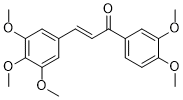MD2-IN-1
This product is for research use only, not for human use. We do not sell to patients.

For small sizes, please check our retail website as below: www.invivochem.com
| Size | Price | Stock |
|---|---|---|
| 250mg | $1350 | Check With Us |
| 500mg | $1950 | Check With Us |
| 1g | $2925 | Check With Us |
Cat #: V4032 CAS #: 111797-22-9 Purity ≥ 98%
Description: MD2-IN-1, a chalcone derivative, is a novel potent and specific inhibitor of Myeloid differentiation protein 2 (MD2) with potential anti-inflammatory activity.
Top Publications Citing Invivochem Products
Publications Citing InvivoChem Products
Product Promise

- Physicochemical and Storage Information
- Protocol
- Related Biological Data
- Stock Solution Preparation
- Quality Control Documentation
| Molecular Weight (MW) | 358.39 |
|---|---|
| Molecular Formula | C20H22O6 |
| CAS No. | 111797-22-9 |
| Storage | -20℃ for 3 years in powder formr |
| -80℃ for 2 years in solvent | |
| Solubility In Vitro | DMSO: 10mMr |
| Water: N/Ar | |
| Ethanol: N/A | |
| SMILES Code | COC1=C(OC)C(OC)=CC(/C=C/C(C2=CC=C(OC)C(OC)=C2)=O)=C1 |
| Synonyms | MD2-IN 1; MD2 IN-1; MD2-IN-1 |
| Protocol | In Vitro | Myeloid differentiation protein 2 (MD2) is a co-receptor of TLR4. Among those derivatives, MD2-IN-1 (compound 20) shows the strongest inhibitory effect on LPS-induced expression of both TNF-α and IL-6. Compare to the vehicle, LPS alone largely increases the amount of TLR4/MD2 complex, while pretreatment with MD2-IN-1 inhibits the increase of TLR4/MD2 complex to the vehicle level. SPR analysis shows that MD2-IN-1 exhibits recognizable binding to rhMD2 protein in a dose-dependent manner, with a KD value of 189 μM, while the KD value of xanthohumol binding to MD2 is 460 μM. Pre-treatment with different doses of MD2-IN-1 dose-dependently reduces FITC-LPS binding to MD2 in cell surface membranes, with a 65% inhibition at 10 μM in terms of mean fluorescence intensity. Pretreatment with MD2-IN-1 also dose-dependently blocks LPS-induced MAPK phosphorylation in the MPMs. |
|---|---|---|
| In Vivo | Administration of MD2-IN-1 evidently reduces the LPS-induced increase in protein concentrations in BALF. The lung wet/dry weight ratio is markedly higher in the LPS-treated group than the control group, and MD2-IN-1 treatment reduces LPS-induced pulmonary edema. LPS also causes observable lung histopathologic changes, including areas of inflammatory infiltration, hemorrhage, interstitial edema, thickening of the alveolar wall, and lung tissue destruction. These histopathological changes are ameliorated in the MD2-IN-1 treatment group. |
These protocols are for reference only. InvivoChem does not
independently validate these methods.
| Solvent volume to be added | Mass (the weight of a compound) | |||
|---|---|---|---|---|
| Mother liquor concentration | 1mg | 5mg | 10mg | 20mg |
| 1mM | 2.7903 mL | 13.9513 mL | 27.9026 mL | 55.8051 mL |
| 5mM | 0.5581 mL | 2.7903 mL | 5.5805 mL | 11.1610 mL |
| 10mM | 0.2790 mL | 1.3951 mL | 2.7903 mL | 5.5805 mL |
| 20mM | 0.1395 mL | 0.6976 mL | 1.3951 mL | 2.7903 mL |
The molarity calculator equation
Mass(g) = Concentration(mol/L) × Volume(L) × Molecular Weight(g/mol)
Mass
=
Concentration
×
Volume
×
Molecular Weight*
The dilution calculator equation
Concentration(start)
×
Volume(start)
=
Concentration(final)
×
Volume(final)
This equation is commonly abbreviated as: C1 V1 = C2 V2
Concentration(start)
C1
×
Volume(start)
V1
=
Concentration(final)
C2
×
Volume(final)
V2
Step One: Enter information below
Dosage mg/kg
Average weight of animals g
Dosing volume per animal µL
Number of animals
Step Two: Enter the in vivo formulation
%DMSO
+
%
+
%Tween 80
+
%ddH2O
Calculation Results:
Working concentration:
mg/ml;
Method for preparing DMSO master liquid:
mg
drug pre-dissolved in
µL
DMSO(Master liquid concentration
mg/mL)
,Please contact us first if the concentration exceeds the DMSO solubility of the batch of drug.
Method for preparing in vivo formulation:
Take
µL
DMSO master liquid, next add
µL
PEG300, mix and clarify, next add
µL
Tween 80,mix and clarify, next add
µL
ddH2O,mix and clarify.
Note:
- (1) Please be sure that the solution is clear before the addition of next solvent. Dissolution methods like vortex, ultrasound or warming and heat may be used to aid dissolving.
- (2) Be sure to add the solvent(s) in order.




































